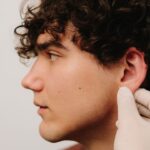Before and After Brow Lift Results
View our gallery of Browlift procedures
performed by Dr. Baker in Washington, DC.
If you are considering a brow lift, this page will provide a basic understanding of the procedure: when it can help, how it is performed, and what results in you can expect. It will not answer all of your questions, since a lot depends on your circumstances. Be sure to ask Dr. Baker if there is anything you do not understand about the procedure.

A forehead lift can smooth the forehead, raise the upper eyelids, and minimize the frown lines that come with aging.

In preparation for a forehead lift, the hair is tied back with rubber bands in front of and behind the incision area. An incision is usually made across the top of the head, just behind the hairline.

The forehead skin is gently lifted and portions of facial muscle and excess skin are removed. The incision is then closed with stitches or clips.

A brow lift is most commonly performed in the 40-60 age range to minimize the visible effects of aging. However, it can also help people of any age who have developed furrows or frown lines due to stress or muscle activity. Individuals with inherited conditions, such as a low, heavy brow or furrowed lines above the nose can achieve a more alert and refreshed look with this procedure.
Brow lift surgery is often performed in conjunction with a facelift to provide a smoother overall look to the face. Eyelid surgery (blepharoplasty) may also be performed at the same time as a forehead lift, especially if a patient has significant skin redundancy in the upper eyelids. Sometimes, patients who believe they need upper eyelid surgery find that a forehead lift better meets their surgical goals.
Bald patients, who have a receding hairline, or who have had previous upper-eyelid surgery may still be good candidates for forehead lift. Dr. Baker will simply alter the incision location or perform a more conservative operation.
Remember, a forehead lift can enhance your appearance and your self-confidence, but it will not necessarily change your looks to match your ideal or cause other people to treat you differently. Before you decide to have surgery, think carefully about your expectations and discuss them in detail with Dr. Baker.
For a better understanding of how a forehead lift might change your appearance, look into a mirror and place the palms of your hands at the outer edges of your eyes, above your eyebrows. Gently draw the skin up to raise the brow and the forehead area. That is approximately what a forehead lift would do for you.
During your consultation with Dr. Baker, he will evaluate your face, including the skin and underlying bone.
Dr. Baker will help you decide which surgical approach will best achieve your cosmetic goals: the classic or open method, the limited incision temporal lift, or the endoscopic forehead lift. He will ensure you understand the technique that he recommends and why he feels it is best for you. The brow and the upper eyelid are intimately related and a thorough evaluation of both structures is necessary to determine the optimal treatment plan for you as the patient. Depending on your concerns, your hairline, and the anticipated period of recovery, Dr. Baker will help you decide which surgical approach will best achieve your cosmetic goals. He will be sure that you understand the technique that he recommends and why he feels it is best for you.
During your consultation, Dr. Baker will discuss your goals for the surgery and ask you about certain medical conditions that could cause problems during or after the procedure, such as uncontrolled high blood pressure, blood-clotting problems, or the tendency to develop large scars. Be sure to tell him if you have had previous facial surgery, if you smoke, or if you take any drugs or medications including aspirin or other drugs that affect clotting.
View our gallery of Browlift procedures
performed by Dr. Baker in Washington, DC.
A forehead lift or brow lift is a procedure that restores a more youthful, refreshed look to the area above the eyes. The procedure corrects drooping brows and improves the horizontal lines and furrows that can make a person appear angry, sad, or tired. During your consultation, Dr. Baker will show you how the procedure is done and go over typical results to help you determine which type of brow lift is best for you.
In a brow lift, the muscles and tissues that cause the furrowing or drooping are removed or altered to smooth the forehead, raise the eyebrows and minimize frown lines. Dr. Baker may use the conventional surgical method, in which the incision is hidden just behind the hairline, or it may be performed with the use of an endoscope, a viewing instrument that allows the procedure to be performed with minimal incisions. Both techniques yield similar results: smoother forehead skin and a more animated appearance.
The classic (open) forehead lift: Before the operation begins, your hair will be tied with rubber bands on either side of the incision line. Your head will not be shaved, but hair that is growing directly in front of the incision line may need to be trimmed. For most patients, a coronal incision will be used. It follows a headphone-like pattern, starting at about ear level and running across the top of the forehead and down the other side of the head. The incision is usually made well behind the hairline so that the scar will not be visible.
If your hairline is high or receding, the incision may be placed just at the hairline, to avoid adding even more height to the forehead. In patients who are bald or losing hair, a mid-scalp incision that follows the natural pattern of the skull bones is sometimes recommended. By wearing your hair down on your forehead, most such scars become relatively inconspicuous. Special planning is sometimes necessary for concealing the scar in male patients, whose hairstyles often do not hide the incisions as well.
Working through the incision, the skin of the forehead is carefully lifted so that the underlying tissue can be removed and the muscles of the forehead can be altered or released. The eyebrows may also be elevated and excess skin at the incision point will be trimmed away to help create a smoother, more youthful appearance.
The endoscopic forehead lift: Typically, an endoscopic forehead lift requires the same preparation steps as the traditional procedure: the hair is tied back and trimmed behind the hairline where the incisions will be made. However, rather than making one long coronal incision, Dr. Baker will make three to five short scalp incisions, each less than an inch in length. An endoscope, which is a pencil-like camera device connected to a television monitor, is inserted through one of the incisions, allowing the surgeon to have a clear view of the muscles and tissues beneath the skin. Using another instrument inserted through a different incision, the forehead skin is lifted and the muscles and underlying tissues are removed or altered to produce a smoother appearance. The eyebrows may also be lifted and secured into their higher position by sutures beneath the skin’s surface or by temporary fixation behind the hairline.
Temporal lift-For patients who have some lateral drooping of the upper eyelids and brows but are happy with the central and medial brow, the temporal lift provides a refreshed look with a shorter incision and a faster recovery. This is an excellent choice for most men and many women in that it corrects the area that bothers the patient the most without creating a surprised or over-elevated look.
Dr. Baker will give you specific instructions to prepare for the procedure, including guidelines on eating and drinking, smoking, and taking and avoiding certain vitamins and medications. Carefully following these instructions will help your surgery and your recovery proceed more smoothly. If your hair is very short, you may wish to let it grow out before surgery, so that it is long enough to hide the scars while they heal.
Whether Dr. Baker performs your forehead lift at Georgetown University Hospital (Washington D.C.), Inova Fairfax Hospital (Falls Church, VA), or an ambulatory surgical facility (McLean, VA), you should arrange for someone to drive you home after your surgery, and to help you out for a day or two.
Most forehead lifts are performed under local anesthesia, combined with a sedative to make you drowsy. You will be awake but relaxed, and although you may feel some tugging and mild discomfort, your forehead will be insensitive to pain.
Dr. Baker may prefer to use general anesthesia, in which case you will sleep through the entire operation.
Complications are rare and usually minor when a forehead lift is performed by a board-certified plastic surgeon. Yet, the possibility of complications must be considered. In rare cases, the nerves that control eyebrow movement may be injured on one or both sides, resulting in a loss of ability to raise the eyebrows or wrinkle the forehead. Additional surgery may be required to correct the problem.
The formation of a broad scar is also a rare complication. This may be treated surgically by removing the wide scar tissue so a new, thinner scar may result. Also, in some patients, hair loss may occur along the scar edges. Loss of sensation along or just beyond the incision line is common, especially with the classic forehead lift procedure. It is usually temporary but may be permanent in some patients.
Infection and bleeding are very rare but are possibilities. You can reduce your risk of complications by closely following Dr. Baker’s instructions both before and after surgery.
Your postoperative instructions and prescriptions will be given to you or faxed to your pharmacy by Cathalene Blake, Dr. Baker’s physician assistant. You will also have her phone number as well as Dr. Baker’s contact information for any post-operative questions or concerns. The immediate post-operative experience for a patient who has had a classic forehead lift may differ significantly from a patient who had the procedure performed endoscopically.
Classic forehead lift: Patients may experience some numbness and temporary discomfort around the incision, which can be controlled with prescription medication. Patients who are prone to headaches may be treated with an additional longer-acting local anesthesia during surgery as a preventive measure.
You may be told to keep your head elevated for two to three days following surgery to keep the swelling down. Swelling may also affect the cheeks and eyes– however, this should begin to disappear in a week or so.
As the nerves heal, numbness on the top of your scalp may be replaced by itching. These sensations may take as long as six months to fully disappear. If bandages were used, they will be removed a day or two after surgery. Most sutures will be removed within two weeks, sometimes in two stages. Some of your hair around the incision may fall out and may temporarily be a bit thinner. Normal growth will usually resume within a few weeks or months. Permanent hair loss is rare.
Endoscopic forehead lift: Patients may experience some numbness, incision discomfort, and mild swelling. Incision site pain is usually minimal but can be controlled with medication, if necessary. Endoscopic forehead lift patients usually experience less of the itching sensation felt by patients who have had the classic forehead lift. The stitches used to close the incisions are usually dissolvable and do not require removal.
Although you should be up and about in a day or two, plan on taking it easy for at least the first week after surgery. You should be able to shower and shampoo your hair within two days, or as soon as the bandage is removed. Most patients are back to work in a week to 10 days. Endoscopic patients may feel ready to return even sooner. Vigorous physical activity should be limited for several weeks, including jogging, bending, heavy housework, sex, or any activity that increases your blood pressure. Prolonged exposure to heat or sun should be limited for several months.
Most of the visible signs of surgery should fade completely within about three weeks. Minor swelling and bruising can be concealed with special camouflage makeup. You may feel a bit tired and let down at first, but your energy level will increase as you begin to look and feel better.
Most patients are pleased with the results of a forehead lift, no matter which surgical method was used. Often, patients don’t realize how much their sagging forehead contributed to the signs of aging until they see how much younger and more rested they appear after the lift. Although a forehead lift does not stop the clock, it can minimize the appearance of aging for years. As time passes, you may want to repeat the procedure.
The overall cost of an Browlift is affected by anesthesia fees, hospital fees, post-surgery garments, and medications. Price is also impacted by medical tests, surgeon’s fees, and the exact techniques employed.
“Dr. Baker, Thank you for improving my ability to breath and for fixing my nose. Now, when I look in the mirror, I see beyond my nose-I see my face. Immediately, my co-workers complemented me on the skills of my surgeon. Despite the swelling, everyone said it looks very natural and that you have done a good job. Thank you for your skills, understanding, and warm personality. I’m glad I chose you. Thanks!”
To learn more about the treatment of Browlift in Washington, DC, contact us and schedule a consultation with board-certified plastic surgeon Dr. Baker.
What Is Gluteal Augmentation?
Gluteal augmentation, or a buttock lift, is a surgical procedure to remove ... Fat grafting has become a natural and long-lasting solution for restoring facial volume and enhancing ... Aging affects everyone, but men do experience unique challenges that can impact their appearance and ...


As Featured In